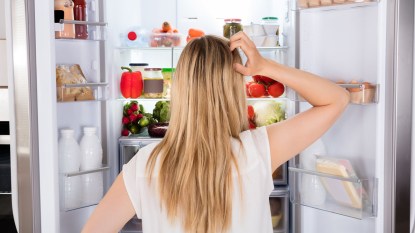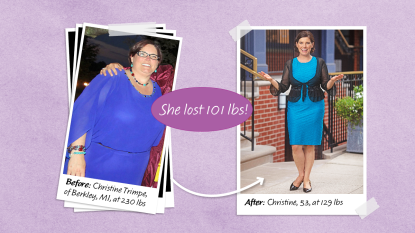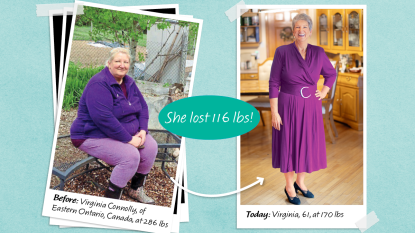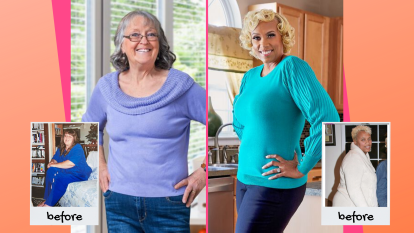Top Nutrition Scientist: Adding Extra Protein To Your First Meal of the Day is The *Best* Way to Fire Up Metabolism
Just ask Pam Hambach: "Weight literally fell off my body. I had to buy a new size of clothing every month!"
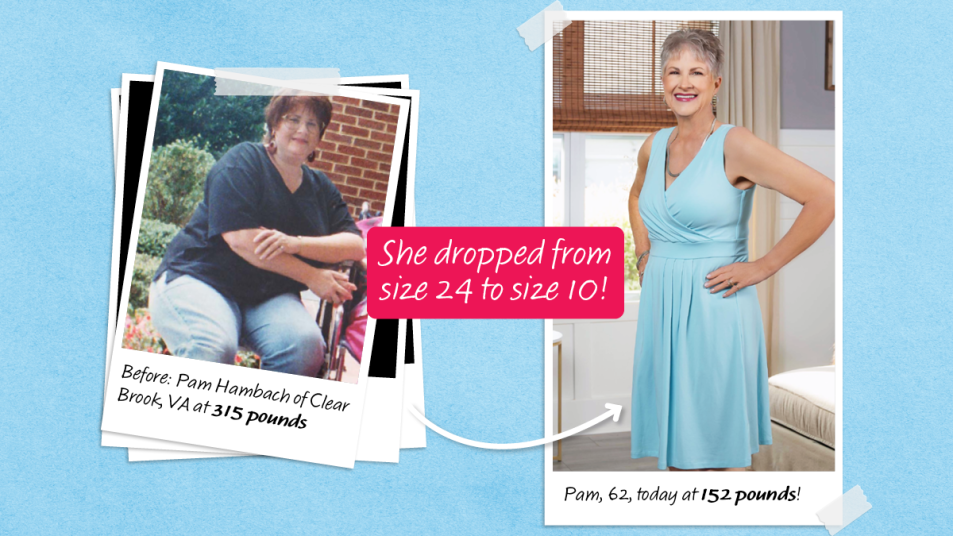
If you’re over 50, you know how pounds can seemingly appear out of nowhere and settle right around your midsection. If you’re like most of us, you may have simply chalked it up to another impossible-to-dodge symptom of menopause, but new research suggests that there may be something else afoot: A shortfall of protein in the early part of the day. Could something so simple really be at the root of the dreaded ‘spare tire’? We talked to experts in the field and took a look at the latest studies — and talked with real women who’d had success losing weight by adding protein first thing — and here’s what we discovered.
The problem: midsection weight gain as we age
We know because we’ve lived it too: trying everything over the years to get those stubborn pounds to drop, but they just seem to nuzzle in deeper and hang on tighter — especially in our midsection. Indeed, Robert Lustig, MD, bestselling author of Fat Chance (Buy from Amazon, $14.95), claims that research shows women see a 400 percent increase in thick belly fat between their 20s and 60s. And this visceral fat is the most dangerous type of fat the body carries. “Just four pounds of visceral fat is enough to make a person weight-loss resistant,” he adds.
According to Paul Arciero, PhD, author of The PRISE Life (Buy from Amazon, $19.99), fueling middle-age weight gain is a phenomenon called “anabolic resistance.” This phrase describes how our body has a harder time turning protein into muscle as we age. In fact, Up to 8 percent of our muscle mass and strength dwindle with each decade after age 30. And as we surrender muscle, we lose the ability to burn calories. Says Arciero: “The factory workers inside our cells responsible for protein synthesis and increasing metabolism doze off.”
The easy solution: eating protein in the morning
The best way to “wake up” an aging metabolism is to start your day eating a lot of protein, according to Stephen Perrine, who as the executive editor of health and wellness for AARP publications hears from many of their 38 million members about the challenges of losing weight over 50. “The average American eats about the right amount of protein every day, she just eats it at the wrong time—all during the second half of the day,” he says.
After pouring over studies and talking with researchers, Perrine concluded that the biggest predictor of weight loss over 50 was how much protein the person was eating, especially before lunch. Increase that protein to 25+ grams for breakfast and 7+ grams for a morning snack, without making any other changes, and weight starts dropping—fast!
Turns out, morning is the prime time to tap into protein’s slimming power. Dr. Arciero explains that our muscles break down during sleep, so skipping breakfast or eating a low-protein meal sets the body up for a day of continued muscle depletion. But eating protein upon waking halts the damage and flips the switch from storing belly fat to burning it. The change is thanks to protein’s high “thermic effect,” or the rate it makes the body burn calories—which is up to 10 times higher than any other nutrient.
“Eating protein early in the day is the single best nutritional strategy to fire up the metabolism, especially to spot-reduce our belly,” asserts Dr. Arciero. Indeed, in a study published in Obesity, older women who ate a protein-heavy breakfast (53 grams!) lost 218 percent more around their middle over 12 weeks than those who ate a protein-heavy dinner.
The National Weight Control Registry, a database of 10,000 people who have successfully kept off their weight for at least one year, proves protein’s potency. World-renowned protein expert Ted Naiman, MD, found that the Registry members shared one thing in common: “It’s not low-carb or low-fat or exercise. It’s getting more protein, especially earlier in the day,” he says. That early dose snuffs out cravings and boosts satiety. (Click through to see how eating a protein-rich breakfast rather than sugary cereal is a food swap that prevents diabetes.)
The hitch: It takes more protein than you’d think
Although protein is a proven slimmer, 90% of us still don’t get enough of it in our first meal, according to the National Institutes of Health. Even a healthy breakfast of three eggs, which contain 18 grams, falls short of what’s needed to kickstart fat burning, causing women to miss out on amazing changes including an increase of 122 percent in weight loss, 150 percent in fat loss and a whopping 220 percent in belly loss, according to Purdue University research comparing protein-focused eaters with traditional eaters.
To the rescue: Perrine’s protein-rich plan, which he tested on more than 100 AARP members. “Don’t get the idea that this is some sort of ‘high-protein diet,’” he says. “The average person following this plan won’t actually eat much, if any, more protein on a given day than she does already. What will happen is that the timing and concentration of that protein is going to change. And the results will be extraordinary.” When test subjects got enough protein in the A.M., they burned fat “as though they were in their 20s again … even without exercise!” Women report losing 12 pounds in a week and feeling 30 years younger with this approach. Plus, downstream benefits include improved energy, blood pressure, cholesterol and A1C blood sugar numbers.
Plus weight stays off for good! “Eating protein can prevent regain after weight loss because retaining muscle helps maintain an optimal metabolic rate,” assures Natasha Turner, ND, author of the upcoming book The Protein Plan. That means: “The higher your metabolic rate, the more calories you burn while sleeping or sitting on the couch!” AARP’s Beth Woodard, 55, has successfully kept off 30 stubborn pounds, mostly from her hips and rear, for three years, thanks to her protein-rich breakfasts. Ready to power-up your intake and burn stubborn fat forever? Read on!
Perrine’s secret to boosting morning protein
Middle-age weight gain is fueled by loss of muscle. But women can outsmart that biological change by eating plenty of protein, which may help reverse muscle depletion and speed metabolism. The result: Your body shifts from storing fat to burning it.
Beth Woodard, 55, has kept off 30 stubborn pounds for three years this way. But timing is key. “You want to get protein in your body as close to waking up as you can,” says Natasha Turner, ND, author of the upcoming book The Protein Plan. Research shows if you don’t eat protein early, you’ve missed the fat-burn window.
That’s why Stephen Perrine created a plan where women eat a breakfast of 25+ grams of protein and a morning snack of 7+ grams to start each day off right. “The more protein, the better,” contends Dr. Arciero. “As women age, protein needs increase. After age 50, they may even need more protein than men!”
Tips for boosting your morning protein intake
So, how do you easily pack dozens of grams of protein into your first meal of the day?
Tip Number 1: Smoothies made with protein powders are a fast and delicious option. Perrine calls them the “secret weapon that makes every day a fat-burning day!” (Click through to discover the best protein powders for women over 50 and the best protein powders for women over 60.)
Tip Number 2: Opt to fill your breakfast plate with other top food sources, like eggs (6 grams each), Greek yogurt (17 grams per 6 ounces), cottage cheese (12 grams per ½ cup), oatmeal (6 grams per cup) and nut butter (8 grams per 2 tablespoons).
Tip Number 3: If you’re a coffee lover, try adding protein powders to coffee to create a protein coffee or “proffee.” Click through for more information on how to whip up your own proffee delight. You can also add even more protein by topping it with cold foam, which is made by frothing milk until it’s pillowy. Click here for tips on how to make cold foam.
Tip Number 4: If you’ve got a sweet tooth, you might want to consider starting your day with protein brownies. Click through to learn more about how women over 50 are using protein brownies to lose weight — and how to make you’re own!
Tip Number 5: Use FIRST’s food chart below to create thousands of delicious, slimming breakfast combinations. Just be sure to get at least 25 grams of protein in each easy, throw-together recipe.
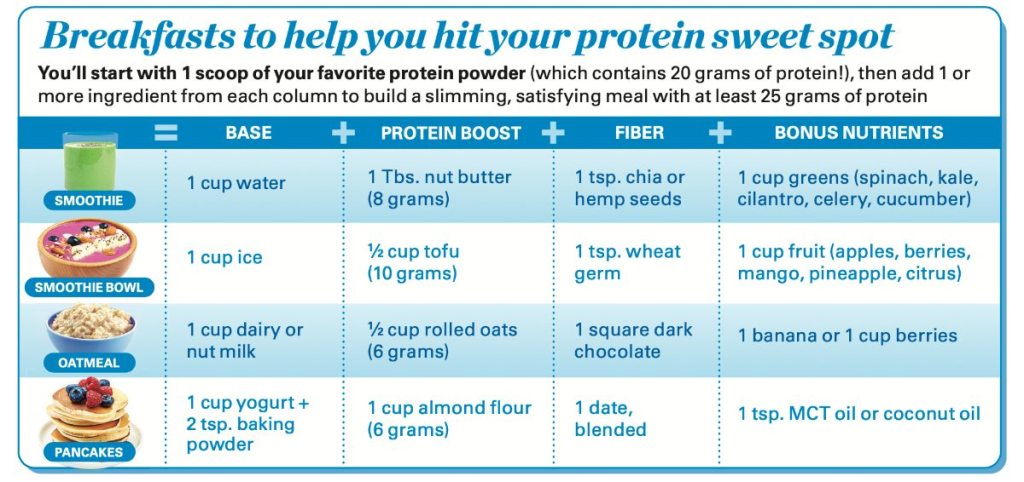
Tip Number 6: Pair fiber with protein. Simply getting enough fiber in your diet may be nearly as effective for slimming as following a strict no-sugar, no-fat diet. So, give yourself a slimming boost by combining fiber and protein (say, snacking on wholegrain crackers and cheese or adding fiber-rich beets to smoothies). Dr. Naiman calls the protein-fiber combo “the ultimate fat-loss diet.” Aim for 5+ grams of fiber at meals and 2+ grams of fiber with snacks.
Tip Number 7: Get this mighty amino. Look for plenty of leucine, the energizing amino acid known to play a major role in muscle building (and fat loss) for older adults. Find it in cottage cheese, red meat, eggs, nuts, and seeds.
Tip Number 8: Don’t stop with breakfast. To keep cravings quelled and energy soaring, add around 25 grams of protein to lunch and dinner too.
To learn more, checkout Stephen Perrine’s book, The Whole Body Reset (Buy from Amazon, $16.39).
Success story: ‘I dropped from a size 24 to a 10!’
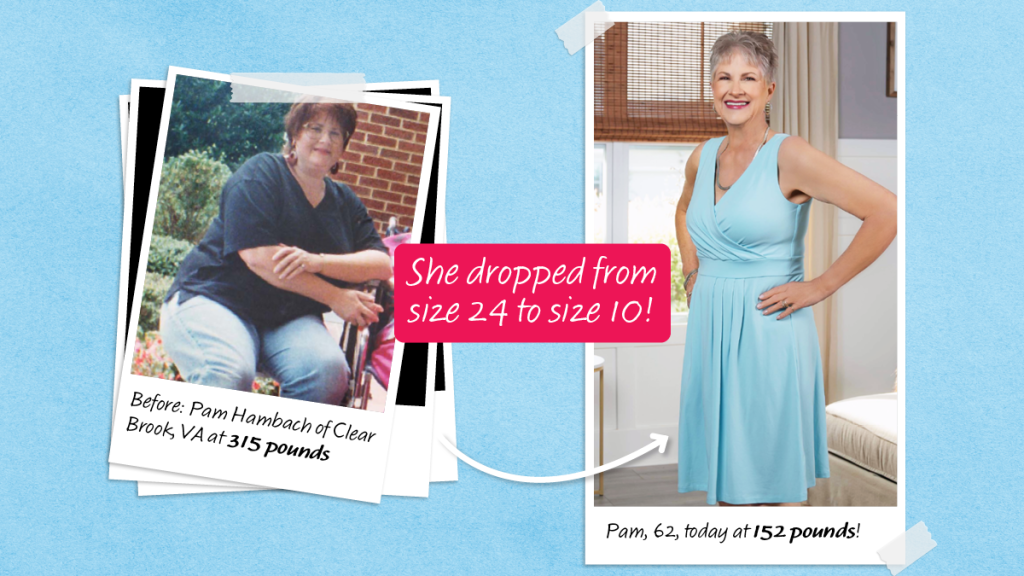
Even in the dark theater, Pam Hambach, 62, felt the eyes of everyone in attendance as she shifted back and forth, trying to shoehorn her body into the too-tight seat. As the tension built, she wondered, How did I let myself get to that point?
“Diets did not work for me,” reveals Pam, thinking of the list that rolled as long as movie credits.
Each fad left her starving and reaching for salty snacks. She shares, “The more I deprived myself, the more cravings I had.” But everything changed when Pam started eating protein-rich breakfasts. “I was never hungry. I just never had an issue with feeling starved.”
Pam lost 13 pounds the first month, thanks to those fruit smoothies with 33 grams of protein, made with either pea protein or whey protein powder, plus clean, whole foods like rolled oats and almond milk. “Weight literally fell off my body. I had to buy a new size of clothing every month,” she recalls. “People said I looked great.” And it wasn’t long before Pam’s cholesterol numbers dramatically improved too. “My doctor sent me a letter that said ‘wow!’”
Cut to the big finale: Today Pam has shed 104 total inches from her body — 15 in her hips!
And her strength and confidence are taking center stage. She beams, “I look younger now than I did when I got married 22 years ago!”
Bonus: High protein breakfasts may improve sleep
Just one extra protein-rich meal a day can lead to sweeter dreams, says a research paper in The American Journal of Clinical Nutrition. In the study of middle-age dieters, those who increased their protein intake by 10 percent by eating a high-protein breakfast experienced better sleep quality (longer slumber and less tossing and turning) than those who didn’t change their protein intake. In fact, by the 16-week mark, the number of poor sleepers plunged by 50 percent! Creator of the protein-energy diet Dr. Naiman, theorizes that eating this way boosts levels of the amino acid tryptophan, which helps make the neurotransmitter serotonin, a precursor to the sleep-inducing hormone melatonin, leading to restful nights.
For more delicious ideas on how to work more protein into your diet:
Proffee: The Delicious Breakfast Helping Women Over 60 Lose Weight Effortlessly
Top Doc Shares the Cottage Cheese Protein Thats Helping Women over 50 Lose Weight
Your Guide to Protein Powders (Plus: The One That Won’t Make You Bloat)
A version of this article originally appeared in our print magazine, First for Women.





